Run-of-the-River Hydro-PV Battery Hybrid System as an Energy Supplier for Local Loads
Abstract
1. Introduction
2. Control Strategy
2.1. System Structure
2.2. Run-of-the-River Hydropower Plant Model
2.3. Energy Management Technique
3. Case Study
3.1. System Description
3.2. PV and Battery Sizing
3.3. One-Year Analysis of Hybrid System
4. Conclusions
Author Contributions
Funding
Conflicts of Interest
References
- REN21. Renewables 2019 Global Status Report; REN21 Secretariat: Paris, France, 2019. [Google Scholar]
- Sawle, Y.; Gupta, S.; Bohre, A.K. Review of hybrid renewable energy systems with comparative analysis of off-grid hybrid system. Renew. Sustain. Energy Rev. 2018, 81, 2217–2235. [Google Scholar] [CrossRef]
- Himri, Y.; Stambouli, A.B.; Draoui, B.; Himri, S. Techno-economical study of hybrid power system for a remote village in Algeria. Energy 2008, 33, 1128–1136. [Google Scholar] [CrossRef]
- Abdullah, M.O.; Yung, V.; Anyi, M.; Othman, A.; Hamid, K.A.; Tarawe, J. Review and comparison study of hybrid diesel/solar/hydro/fuel cell energy schemes for a rural ICT Telecenter. Energy 2010, 35, 639–646. [Google Scholar] [CrossRef]
- Obukhov, S.; Ibrahim, A.; Tolba, M.A.; El-Rifaie, A.M. Power Balance Management of an Autonomous Hybrid Energy System Based on the Dual-Energy Storage. Energies 2019, 12, 4690. [Google Scholar] [CrossRef]
- Javed, M.S.; Ma, T.; Jurasz, J.; Amin, M.Y. Solar and wind power generation systems with pumped hydro storage: Review and future perspectives. Renew. Energy 2019, 148, 176–192. [Google Scholar] [CrossRef]
- Kapsali, M.; Anagnostopoulos, J.; Kaldellis, J. Wind powered pumped-hydro storage systems for remote islands: A complete sensitivity analysis based on economic perspectives. Appl. Energy 2012, 99, 430–444. [Google Scholar] [CrossRef]
- Ghaisi, M.; Rahmani, M.; Gharghabi, P.; Zoghi, A.; Hosseinian, S.H. Scheduling a wind hydro-pumped-storage unit con-sidering the economical optimization. Am. J. Electr. Electron. Eng. 2017, 5, 16–22. [Google Scholar]
- Zhao, J.; Graves, K.; Wang, C.; Liao, G.; Yeh, C.-P. A hybrid electric/hydro storage solution for standalone photovoltaic applications in remote areas. In Proceedings of the 2012 IEEE Power and Energy Society General Meeting, San Diego, CA, USA, 22–26 July 2012; pp. 1–6. [Google Scholar] [CrossRef]
- Khare, V.; Nema, S.; Baredar, P. Solar–wind hybrid renewable energy system: A review. Renew. Sustain. Energy Rev. 2016, 58, 23–33. [Google Scholar] [CrossRef]
- Bhayo, B.A.; Al-Kayiem, H.H.; Gilani, S.I.; Ismail, F.B. Power management optimization of hybrid solar photovoltaic-battery integrated with pumped-hydro-storage system for standalone electricity generation. Energy Convers. Manag. 2020, 215, 112942. [Google Scholar] [CrossRef]
- Javed, M.S.; Zhong, D.; Ma, T.; Song, A.; Ahmed, S. Hybrid pumped hydro and battery storage for renewable energy based power supply system. Appl. Energy 2019, 257, 114026. [Google Scholar] [CrossRef]
- Zhang, Y.; Ma, C.; Lian, J.; Pang, X.; Qiao, Y.; Chaima, E. Optimal photovoltaic capacity of large-scale hydro-photovoltaic complementary systems considering electricity delivery demand and reservoir characteristics. Energy Convers. Manag. 2019, 195, 597–608. [Google Scholar] [CrossRef]
- Jurasz, J.; Ciapała, B. Integrating photovoltaics into energy systems by using a run-off-river power plant with pondage to smooth energy exchange with the power gird. Appl. Energy 2017, 198, 21–35. [Google Scholar] [CrossRef]
- Li, F.-F.; Qiu, J. Multi-objective optimization for integrated hydro–photovoltaic power system. Appl. Energy 2016, 167, 377–384. [Google Scholar] [CrossRef]
- Fo, F.A.D.; Beluco, A.; Rossini, E.G.; de Souza, J. Influence of Time Complementarity on Energy Storage through Batteries in Hydro PV Hybrid Energy System. Comput. Water Energy Environ. Eng. 2018, 07, 142–159. [Google Scholar] [CrossRef][Green Version]
- Liu, Z.; Zhang, Z.; Zhuo, R.; Wang, X. Optimal operation of independent regional power grid with multiple wind-solar-hydro-battery power. Appl. Energy 2018, 235, 1541–1550. [Google Scholar] [CrossRef]
- Hoseinzadeh, S.; Ghasemi, M.H.; Heyns, S. Application of hybrid systems in solution of low power generation at hot seasons for micro hydro systems. Renew. Energy 2020, 160, 323–332. [Google Scholar] [CrossRef]
- Kittner, N.; Gheewala, S.H.; Kammen, D.M. Energy return on investment (EROI) of mini-hydro and solar PV systems designed for a mini-grid. Renew. Energy 2016, 99, 410–419. [Google Scholar] [CrossRef]
- Ye, L.; Sun, H.B.; Song, X.R.; Li, L.C. Dynamic modeling of a hybrid wind/solar/hydro microgrid in EMTP/ATP. Renew. Energy 2012, 39, 96–106. [Google Scholar] [CrossRef]
- Borkowski, D.; Wegiel, T. Small Hydropower Plant with Integrated Turbine-Generators Working at Variable Speed. IEEE Trans. Energy Convers. 2013, 28, 452–459. [Google Scholar] [CrossRef]
- Borkowski, D. Small Hydropower Plant as a Supplier for the Primary Energy Consumer. In Proceedings of the 16th International Scientific Conference on Electric Power Engineering, Kouty nad Desnou, Czech Republic, 20–22 May 2015; pp. 148–151, ISBN 978-1-4673-6787-5. [Google Scholar]
- Sayers, A.T. Hydraulic and Compressible Flow Turbomachines; Mcgraw-Hill: Berkshire, UK, 1990. [Google Scholar]
- Dixon, S.L.; Hall, C.A. Fluid Mechanics and Thermodynamics of Turbomachinery; Elsevier: Amsterdam, The Netherlands, 2010. [Google Scholar]
- Borkowski, D. Analytical Model of Small Hydropower Plant Working at Variable Speed. IEEE Trans. Energy Convers. 2018, 33, 1886–1894. [Google Scholar] [CrossRef]
- Borkowski, D. Identification of the optimal control characteristics of a small hydropower plant using artificial neural networks and the support vector machines method. J. Hydraul. Res. 2018, 57, 715–723. [Google Scholar] [CrossRef]
- ISO/DIS 1100-2 Measurement of Liquid Flow in Open Channels—Part 2: Determination of the Stage-Discharge Relation; ISO: Geneva, Switzerland, 2010.
- Gao, J.; Dai, L.; Liu, X.; Du, X.; Luo, D.; Huang, S. Variable-Speed Hydropower Generation: System Modeling, Optimal Control, and Experimental Validation. IEEE Trans. Ind. Electron. 2020, 68, 10902–10912. [Google Scholar] [CrossRef]
- Vasudevan, K.R.; Ramachandaramurthy, V.K.; Venugopal, G.; Ekanayake, J.; Tiong, S. Variable speed pumped hydro storage: A review of converters, controls and energy management strategies. Renew. Sustain. Energy Rev. 2020, 135, 110156. [Google Scholar] [CrossRef]
- Kubiak-Wójcicka, K.; Machula, S. Influence of Climate Changes on the State of Water Resources in Poland and Their Usage. Geosciences 2020, 10, 312. [Google Scholar] [CrossRef]
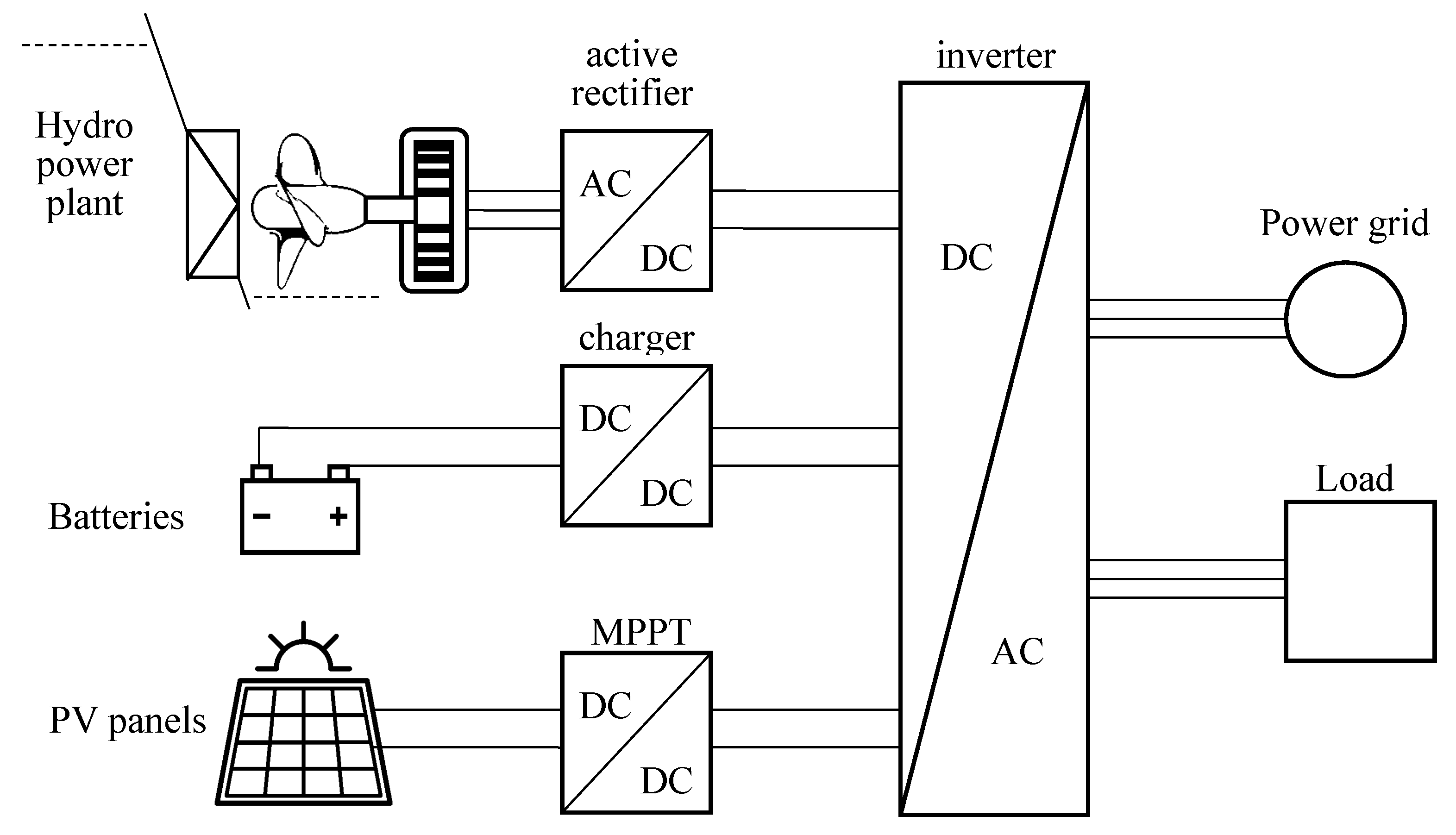



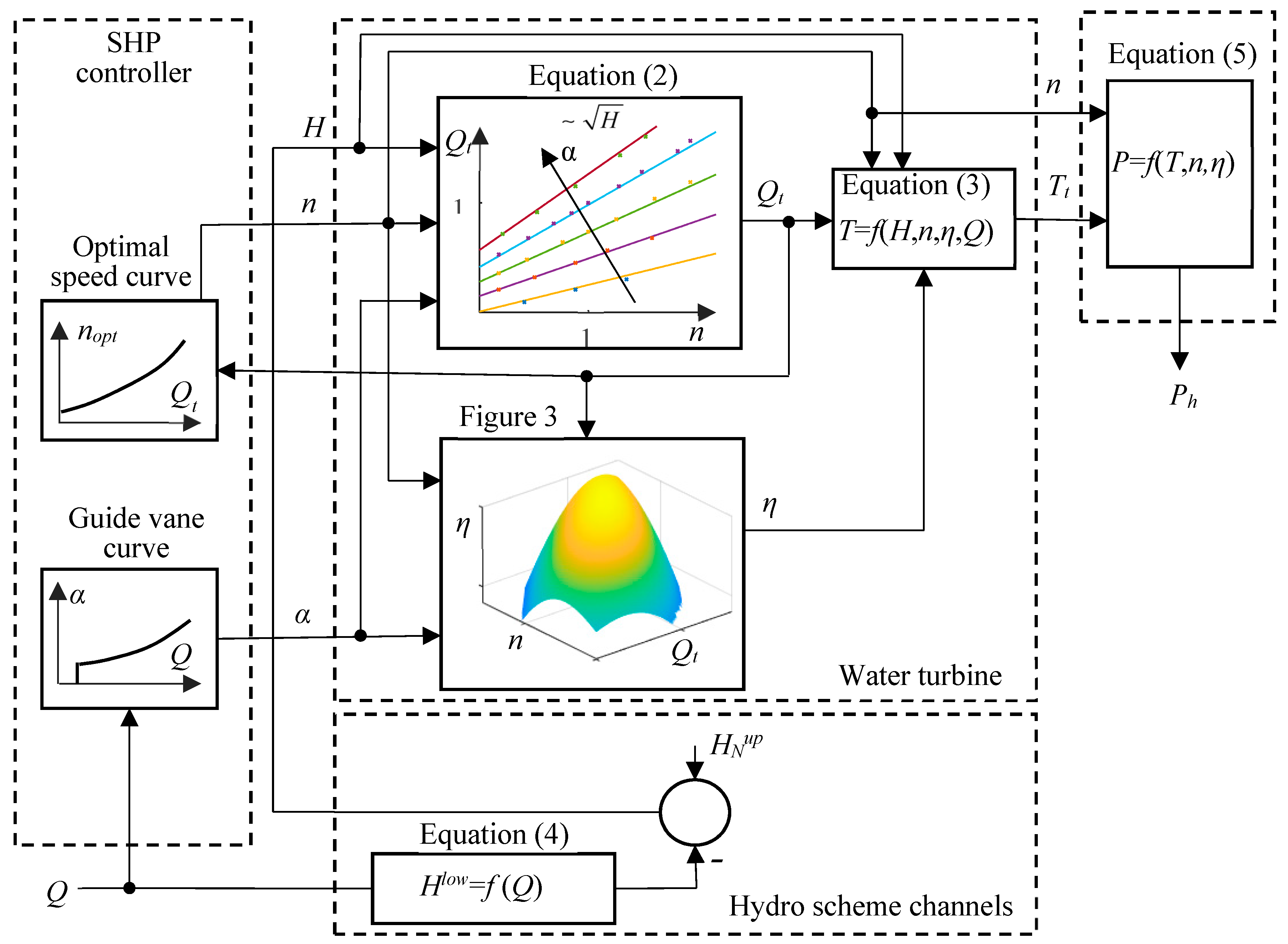
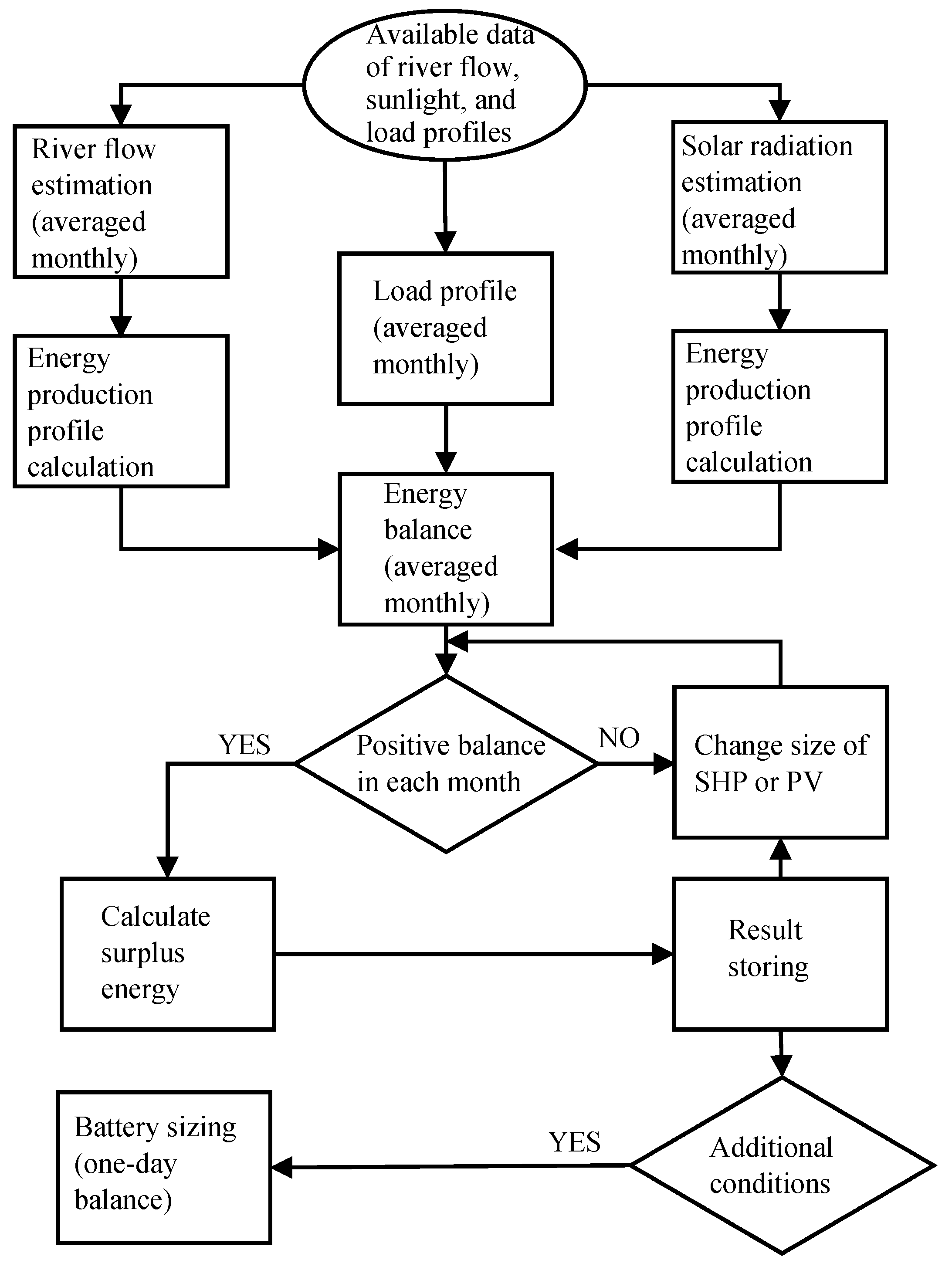


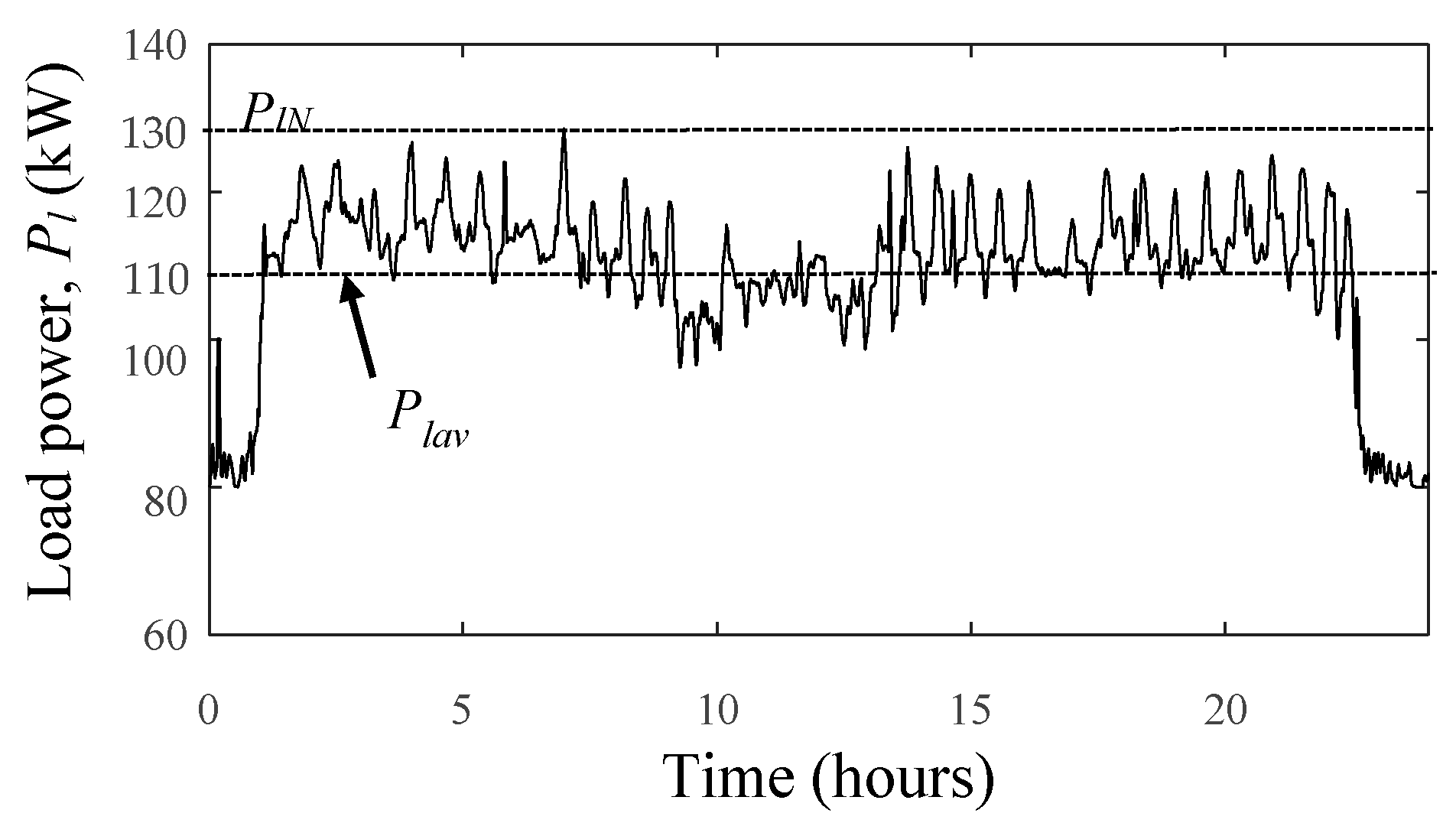

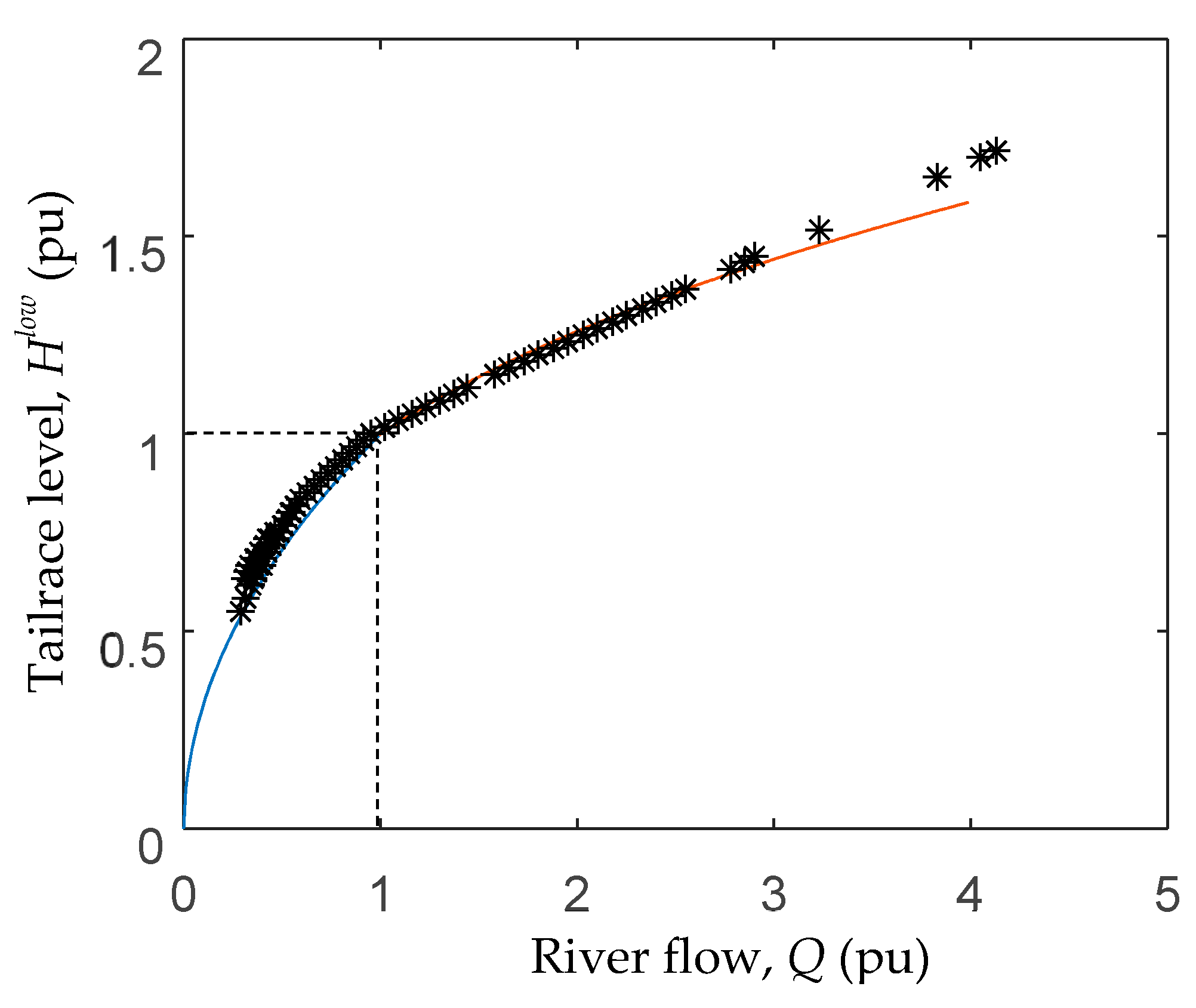




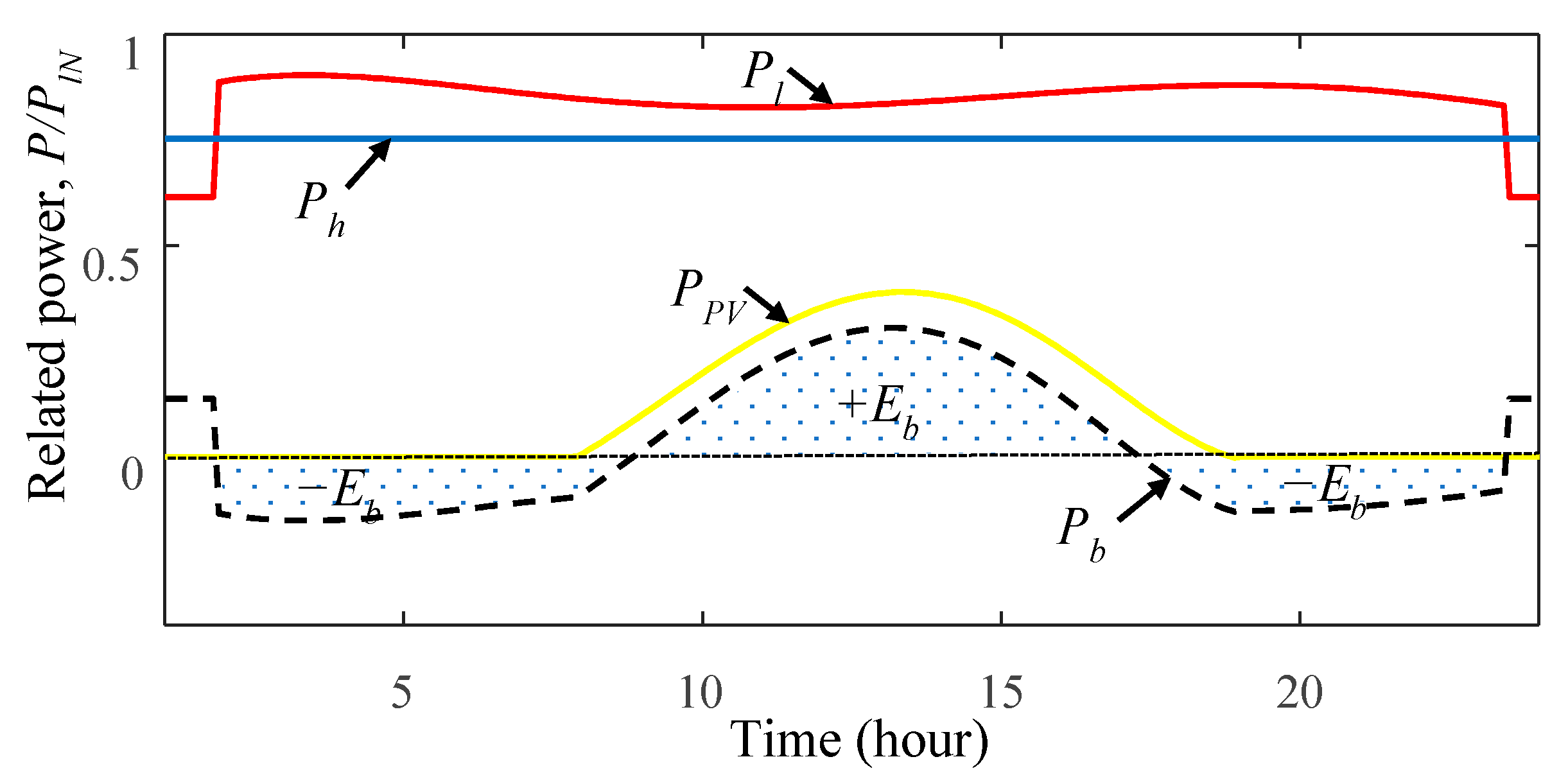

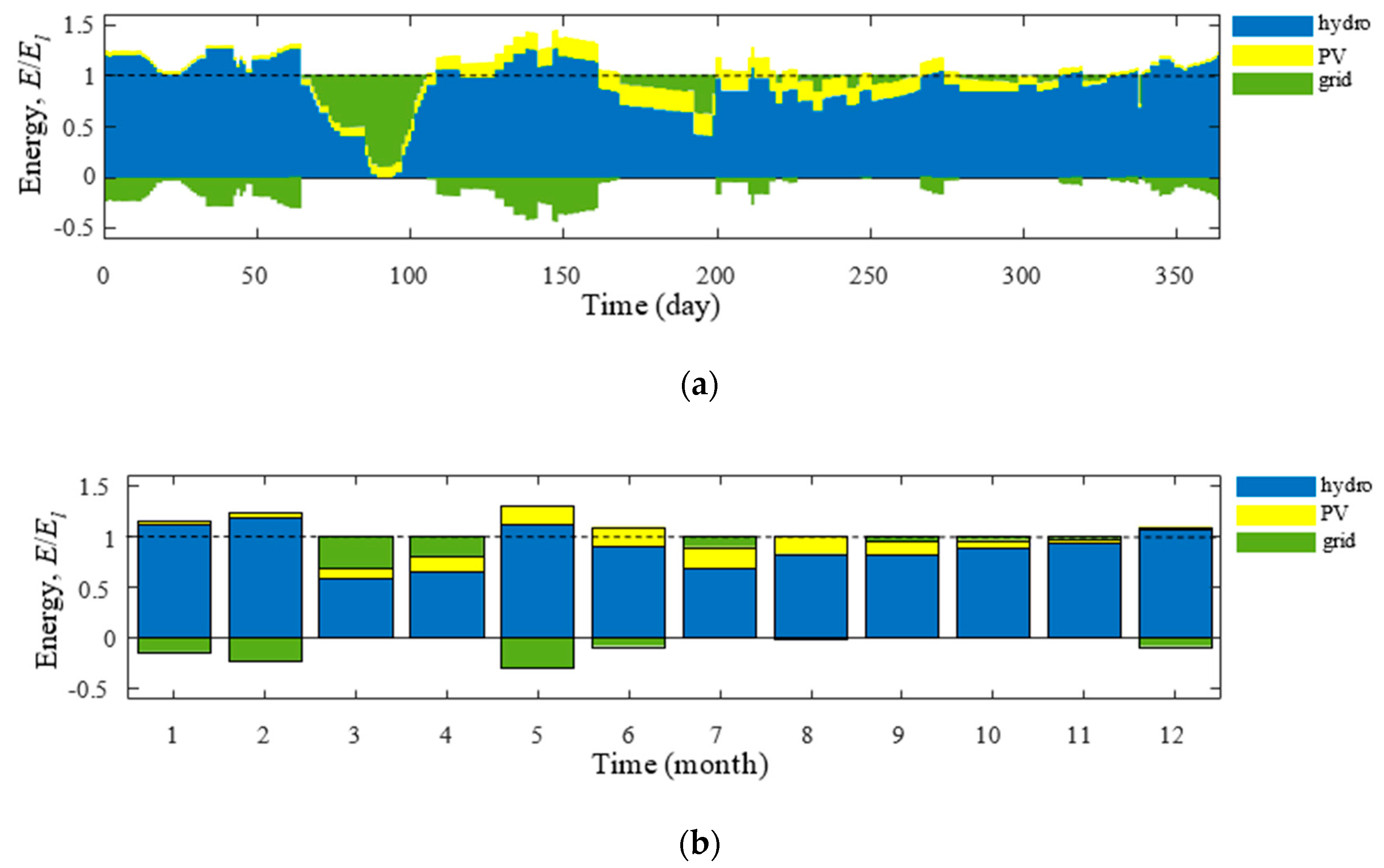
Publisher’s Note: MDPI stays neutral with regard to jurisdictional claims in published maps and institutional affiliations. |
© 2021 by the authors. Licensee MDPI, Basel, Switzerland. This article is an open access article distributed under the terms and conditions of the Creative Commons Attribution (CC BY) license (https://creativecommons.org/licenses/by/4.0/).
Share and Cite
Borkowski, D.; Cholewa, D.; Korzeń, A. Run-of-the-River Hydro-PV Battery Hybrid System as an Energy Supplier for Local Loads. Energies 2021, 14, 5160. https://doi.org/10.3390/en14165160
Borkowski D, Cholewa D, Korzeń A. Run-of-the-River Hydro-PV Battery Hybrid System as an Energy Supplier for Local Loads. Energies. 2021; 14(16):5160. https://doi.org/10.3390/en14165160
Chicago/Turabian StyleBorkowski, Dariusz, Dariusz Cholewa, and Anna Korzeń. 2021. "Run-of-the-River Hydro-PV Battery Hybrid System as an Energy Supplier for Local Loads" Energies 14, no. 16: 5160. https://doi.org/10.3390/en14165160
APA StyleBorkowski, D., Cholewa, D., & Korzeń, A. (2021). Run-of-the-River Hydro-PV Battery Hybrid System as an Energy Supplier for Local Loads. Energies, 14(16), 5160. https://doi.org/10.3390/en14165160






